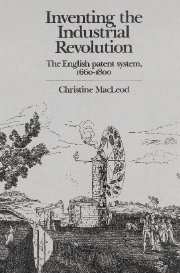Book contents
- Frontmatter
- Contents
- List of tables and figure
- Acknowledgements
- List of abbreviations
- Notes on style
- Introduction
- 1 Patents 1550–1660: law, policy and controversy
- 2 The later-Stuart patent grant – an instrument of policy?
- 3 The development of the patent system, 1660–1800
- 4 The judiciary and the enforcement of patent rights
- 5 The decision to patent
- 6 Invention outside the patent system
- 7 Patents in a capitalist economy
- 8 The long-term rise in patents
- 9 The goals of invention
- 10 Patents: criticisms and alternatives
- 11 A new concept of invention
- Notes
- Bibliography
- Index
8 - The long-term rise in patents
Published online by Cambridge University Press: 28 October 2009
- Frontmatter
- Contents
- List of tables and figure
- Acknowledgements
- List of abbreviations
- Notes on style
- Introduction
- 1 Patents 1550–1660: law, policy and controversy
- 2 The later-Stuart patent grant – an instrument of policy?
- 3 The development of the patent system, 1660–1800
- 4 The judiciary and the enforcement of patent rights
- 5 The decision to patent
- 6 Invention outside the patent system
- 7 Patents in a capitalist economy
- 8 The long-term rise in patents
- 9 The goals of invention
- 10 Patents: criticisms and alternatives
- 11 A new concept of invention
- Notes
- Bibliography
- Index
Summary
When John Davies, who combined employment at the Rolls Chapel Office with a patent agent's practice, published his treatise on patent law in 1816, he commented on the spectacular growth of business he had witnessed over the preceding thirty years.
Whether the great increase in the number of patents in the present age has arisen from the increased ingenuity, or from the greater spirit of speculation of our contemporaries, or from what other cause, is not for us to inquire.
Davies's example notwithstanding, I shall now draw together points made in the previous three chapters in an attempt to explain the late-eighteenth-century rise in the patent totals. Fifty years before Davies wrote, the annual figures had started their exponential climb: in 1766 the unprecedented total of 31 had been reached; in 1816 Davies and his colleagues dealt with 118 patents.
It can never be disproved that the positivist explanation of the rise patents – an upsurge in inventive activity or of new found technical talent – is incorrect. The list of well-known inventions that date from the later eighteenth century suggests that it certainly contains some degree of truth (though partly at the expense of the Saverys, Newcomens, Wyatts and Pauls of the century's first half). But to ask why it should have occurred then and in England is to enter anything but a positivist realm: from the impact of the scientific revolution to explanations couched in terms of socio-psychology, historians continue to speculate, while some take refuge in the ‘randomness’ of invention's timing.
- Type
- Chapter
- Information
- Inventing the Industrial RevolutionThe English Patent System, 1660–1800, pp. 144 - 157Publisher: Cambridge University PressPrint publication year: 1988
- 1
- Cited by



